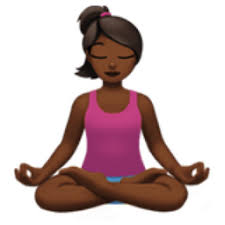Lately, I’ve been using dynamic meditation as a way to relieve stress and I must say . . . it works!
As you know, meditation is rooted in Buddhist and Hindu practices. Kundalini  meditation is similar to dynamic mediation, but it’s not quite the same. I first began to learn about dynamic mediation on the internet.
meditation is similar to dynamic mediation, but it’s not quite the same. I first began to learn about dynamic mediation on the internet.
Bahgwan Shree Osho Rajneesh (December 1931-November 1990) is the creator of dynamic meditation. It’s an effective method of uprooting repressed emotions or unwanted energy and then releasing it. It’s like a quick pick me up, if you’re able to maintain yourself in a small space. For your first time, try to complete the exercise when you’re alone or maybe with a leader whose familiar.
When practicing dynamic mediation respect the body, space, property and belongings of yourself and others around you. Practicing this particular meditation in public could alert others and make them feel afraid, uncomfortable or concerned. This is not an opportunity to physically or mentally harm others, under any circumstances.
Dynamic mediation is a physical psychotherapeutic exercise used for stress, anxiety, depression, and anger. This is a courageous effort to move the negative energy out of our body and in turn—out of our life for good!
out of our body and in turn—out of our life for good!
First Stage
Stand up straight with your legs shoulder width apart. Make sure you have enough space to move your entire body. For this stage of the exercise, breathing is everything. Focus on your breathing during the first stage. You’re going to keep changing the way you breathe every time you take a breath. Don’t breath the same. Change your breathing pattern and make them deep, quick breaths through your nose. Exaggerate the exhalation from your nose. Give it all your energy! Give in completely to your breathing. Notice what you feel when you change your breathing and make it erratic like that. How does your back feel? What about your chest? How is your body responding to the sudden change? If you feel a cramp, out of breath, if you’re sweating, or feeling winded, than you’re doing it right! Soon you will be ready to move on to the next stage. Feel everything from the inside out. This stage is supposed to take place for 10 minutes.
Second Stage
Allow all of your emotion to pour out of you. Let your body be free, but stay in the perimeter, room or private space. Expose your emotions. Any emotion. This is a free space to behave and say what you wouldn’t in front of other people. Channel your feelings into body language and make sounds that express your feelings. It can be verbal or nonverbal expression (such as a grunt or a scream). If you’re able to be as loud as you want to be than do it. Let your feelings take over. Don’t hold back. Allow your emotions to change. Don’t feel self-conscience about your movements, the sounds your making or the things you’re saying. Don’t let your mind make you feel like you need to behave yourself. Don’t think too hard about your feelings, express them as they come and change. Do everything from the inside out. Just let it flow. You have total free expression during this stage, let it be from your heart. Any emotions that you’ve been holding, which feel like weights, let them out. Nobody’s looking at you. Cry if you need to cry, sing if you want to sing, throw your arms in the air, sit with your legs folded in front of you, whatever you want to do. Just don’t hurt anyone or be destructive. Nothing dangerous. You’re able to throw a fit though. Pay attention to your emotions. Focus on them. This stage last 10 minutes. (If you end up in a seated position you have to stand back up for the third stage).
Third Stage
Close your eyes were you stand with you legs shoulder width apart like in the beginning stage. Start hopping up and down, not too hard—hence the word hopping. Unlock your knees for jumping and land on your feet flat—as opposed to your tippy toes. You will be doing several light jumps back to back, continuously. Keep going for ten minutes chanting the sound “whooo” whooo” ( you can do this without a loud sound if needed, but still use your breath to whisper or breathe out the sound). It’s important to do the chanting, it is the way to push the negative energy out through your airway passage. This isn’t worship, calling out names or anything pertaining to religion. This is only for your exercise and well-being. Do this stage of the exercise in 15 minutes.
Fourth Stage
Stand completely still with both your arms raised, eyes closed still observing your thoughts, feelings and everything you hear going on around you. Stand as stiff as a board or a planted tree. Don’t scratch an itch, don’t move a pinch, except your breathing. You’re chest is moving up and down. That’s it. You should be standing in your beginning stance with both your hands above your head, reaching upward. Notice the way the physical body feels. Be mindful at this stage. Try to acknowledge every sensation and everything around you with your eyes still closed. Do this stage of the exercise in 15 minutes just like the third stage.
Fifth Stage
Now move into a dance, a feel good dance. Do a real feel good dance, even if it’s stupid. If you like to jump high, then do it, if you like to spin around in circles. This isn’t dance practice. You don’t have to look perfect and nobody’s watching. You may add music to this stage because it’s appropriate. Having fun with it is the purpose of the fifth stage. Do a dance that feels good to your body. Do this for 15 minutes as well.
Well . . . that was it!
How do you feel? . . .

I hope you feel great and energized!
Now that you’ve read what I know about dynamic meditations, here is the link to the YouTube video. https://youtu.be/bRXcbXnLwvM
See for yourself. I enjoy it. If it’s not for you, I understand. I just thought I’d push it out there for those in need of a relief that’s non-toxic and non-worship.
Health Benefits of Dynamic Meditation
- Good physical exercise
- Connects the mind, body and spirit
- Emotional Release-catharsis (release repressed emotions)
- Useful breathing technique
- Lowers stress (cortisol) levels
Well, until next time . . . take care my internet family! This is Truly K. Bradley signing out.
Related links:



